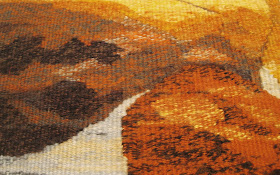I know it is such a short video but couldnt wait to share it with you all. Congratulations Judy for this wonderful tapestry!
New tapestry released today!

The charcoal fallen from their torches, their fires, a few objects, bones and flint tools left on the ground are the remains of meals or of sundry activities. They are also part of the documentation unwittingly left by prehistoric people in the caves. From their study, one can say that in most cases painted or engraved caves were not inhabited, at least for long periods. Fires were temporary and remains are relatively scarce. (1)
It is precisely what motivated Judy to work on such a beautiful tapestry.
Today she had the joy of seeing it take flight released from its loom.
The gradation of her wools was superb and the combination of her hues and tones made the desired effect in the full piece.
The majority of human history is a history about which we know almost nothing. But we do know that something as uniquely human as artistic activity began to emerge on a grand scale nearly forty thousand years ago (Lewis-Williams & Clottes 1998). Staggering finds have been made in Australia, Africa, parts of Asia, and in various parts of Europe. We are dealing then with a universal phenomenon. While the spectacular caves of Southwestern Europe typically get all the fanfare, impressive finds of prehistorical artistry come from all over the globe. (2)
Cave paintings is an art that even now, after millions of years it still surprises us as well as creates such a fascination.
Some anthropologists and art-historians also theorize that the paintings could be an account of past hunting success, or could represent a mystical ritual in order to improve future hunting endeavors. This latter theory is supported by the overlapping images of one group of animals in the same cave-location as another group of animals, suggesting that one area of the cave was more successful for predicting a plentiful hunting excursion.

The techniques, so Judy comments- is not only painting on the walls.
On behalf of the Oakville Tapestry Studio I would like to congratulate Judy for her wonderful work. This tapestry is not only an inspiration for the technique but also to encourage us to learn more about this fascinating period of Human developement. Yes, we have advanced in techniques, but what we need yet to learn from these artists is still to come. Colour & composition dialogue side by side in these wonderful caves.
Way to go Judy. Cant wait to see your next project on assure techniques. Surprise us all again!
(1) Paleolithic Cave Paintings and Rock Art in France : Extracted from the Adorant magazine 2002
| by Dr Jean Clottes |
(2) THE SACRED CAVE: TOWARDS AN ASSUMPTION OF RELIGION IN THE UPPER PALEOLITHIC
John J. McGraw, Department of Anthropology, University of California, San Diego, CA 92093 (jmcgraw@ucsd.edu)




que bela tapeçaria,resgando os rupestres e cultuando a arte de tecer,duas coisas muito antigas,parabéns judy
ReplyDeleteMuito obrigado Neia. Mantenha-se em contacto para ver o próximo tapeçaria!
ReplyDeleteThank you Neia.
It's really gorgeous!
ReplyDeleteTannaz